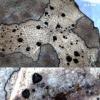
02-01-2026 17:43
MARICEL PATINOHi there, although I couldn't see the fruitbody, I

04-01-2026 17:45
 Stephen Martin Mifsud
Stephen Martin Mifsud
I was happy to find these orange asmocyetes which

03-01-2026 13:08
Niek SchrierHi all,We found groups of perithecia on a Lecanora

29-12-2025 17:44
Isabelle CharissouBonjour,J'aimerais savoir si d'autres personnes au

01-01-2026 18:35
Original loamy soil aside a artificial lake.The co

31-12-2025 19:27
Collected from loamy soil, at waterside (completel
Coccomyces on Quercus leaves
Garrido-Benavent Isaac,
24-02-2014 18:47
This is a Coccomyces that was growing on dead leaves of Q. ilex subs. rotundifolia and Q. coccifera, in eastern Spain at around 200 m asl.
Following a key shared by B. Declercq here in Ascofrance, I'm not quite sure if my specimens belong to C. dentatus or C. coronatus. Macroscopically, they are more related to the former, microscopically to the later though. Perhaps there are other "intermediate species" which weren't included in that key.
Some of the traits that could help to identify it are:
- Spores 63-87 x 2'5-3'3(4) um, with one rounded end and the other somewhat sharpened, abundant granular content.
- Asci between 95-120 x 9-11 um.
- Paraphyses with more or less clavate tips, straight or slightly curved, surrounded by gel and 3-4 um width.
- Macroscopically, there can be seen 3 to 5 black, irregular teeth. Ascocarp diameter not exceeding 1mm diameter. Hymenium whitish to ivory. Despite I've not studied it yet, there are some black, smaller dots around the ascocarps that could be pycnidia.
Any suggestion will be appreciated!!
Cheers
Isaac




